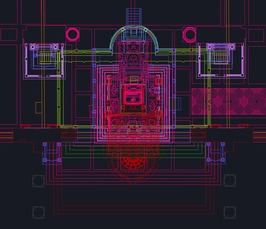Visualizing Complexities: Practices and Heuristics of Digital Models in Art History
International Workshop
- Participation to the workshop is limited to the group of speakers.
- Beginn: 10.12.2020 14:00
- Ende: 11.12.2020 19:00
- Vortragende(r): International Workshop
- Ort: Online via zoom
- Kontakt: rossi@biblhertz.it

Modeling technologies (GIS, photogrammetry, laser scanning, VR, AR, or BIM) can assist not only in visualizing, but also in measuring, reconstructing and, thus, analyzing works of art and architecture. The interdisciplinarity of digital approaches invites diverse conventions, and as the media used for digital visualizations are adopted across disciplines and their hermeneutics contested, the resulting epistemes are naturally hybrid.
This two-day workshop addresses some of the following questions: How to balance the allure of realism and the desire for aesthetic appeal against scholarly demands for restrained truth? How can digital models disclose both fact and uncertainty? What strategies can assess the validity and reliability of digital models in a peer-reviewed fashion? What are the benefits of adopting an ontology that drives workflows and standardizes methods.
Due to the nature of the meeting, participation to the
workshop is limited to the group of speakers.
The Keynote Lecture by Prof. Piotr Kuroczyński will
be open to the public. Please follow THIS LINK.
Program
THURSDAY, DECEMBER 10, 2020
14:00 Welcome and Introduction
TANJA MICHALSKY, Bibliotheca Hertziana - Max Planck Institute for Art History
NICOLA CAMERLENGHI, Dartmouth College
14:30 Session 1
Moderation: Nicola Camerlenghi
GIACOMO LANDESCHI, Lund University
What Is a 3D Model and Why Do We Model? Some Reflections Built Upon Archaeological Case Studies
GIULIA BORDI and ANGELICA FEDERICI, Università degli Studi Roma Tre
Visualizing Medieval Rome. Digital Storytelling of the City and its Churches
16:00 Break
16:15 Session 2
Moderation: Elisabetta Scirocco
DONAL COOPER and FABRIZIO NEVOLA, University of Cambridge - University of Exeter
Immersive Renaissance – New Narratives for a Spatialized Understanding of Art and Architecture
NICOLA CAMERLENGHI, Dartmouth College
Virtual St. Paul’s, 2.0 – The Annotated Model
18:00 Break
18:15 Keynote Lecture – Online event via Zoom. Please follow THIS LINK.
PIOTR KUROCZYŃSKI, Hochschule Mainz
The Digital 3D Reconstruction as Research Tool - Challenges and Potentials
FRIDAY, DECEMBER 11, 2020
14:00 Session 3
Moderation: Elisabetta Scirocco & Nicola Camerlenghi
LEX BOSMAN, University of Amsterdam
The Fourth-Century S. Giovanni in Laterano in the Twenty-First Century: Digital Approaches and Reconstruction
RUGGERO LONGO, IMT School for Advanced Studies / Bibliotheca Hertziana - Max Planck Institute
Digitizing the Norman Palace. Methodology, Potential and Limits of the Palermo Royal Palace Project
PAOLO BORIN and ANDREA GIORDANO, Università degli Studi di Padova
Representing Complexities: Bim Concepts for "Visualizing Cities."
16:15 Break
16:30 Session 4
Moderation: Tanja Michalsky
ROBERTO SCOPIGNO, National Research Council (CNR), ISTI, Pisa
Managing Complexity of Visual Media: A Near-to-Reach Goal?
LEONARDO IMPETT, Durham University
Corpus Questions in the History of Art
18:00 Break
18:30 Roundtable Discussion
Moderation: Tanja Michalsky
Scientific Organization: Tanja Michalsky, Nicola Camerlenghi, Elisabetta Scirocco
Image: St. Paul’s Outside the Walls, Rome. Composite plan of apse, transept, and the eastern end of the nave (404-2020). Model and image by Nicola Camerlenghi & Evan Gallitelli